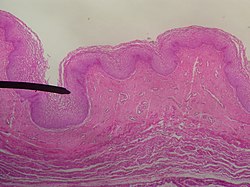Gray1110
Diagrams to show the development of male and female generative organs from a common type. (Allen Thomson.) A.—Diagram of the primitive urogenital organs in the embryo previous to sexual distinction.
- 3. Ureter.
- 4. Urinary bladder.
- 5. Urachus.
- cl. Cloaca.
- cp. Elevation which becomes clitoris or penis (Genital tubercle).
- i. Lower part of the intestine.
- ls. Fold of integument from which the labia majora or scrotum are formed.
- m, m. Right and left Müllerian ducts uniting together and running with the Wolffian ducts in gc, the genital cord.
- ot. The genital ridge from which either the ovary or testis is formed.
- ug. Sinus urogenitalis.
- W. Left Wolffian body.
- w, w. Right and left Wolffian ducts.
B.—Diagram of the female type of sexual organs.
- C. Greater vestibular gland, and immediately above it the urethra.
- cc. Corpus cavernosum clitoridis.
- dG. Remains of the left Wolffian duct, such as give rise to the duct of Gärtner, represented by dotted lines; that of the right side is marked w.
- f. The abdominal opening of the left uterine tube.
- g. Round ligament, corresponding to gubernaculum.
- h. Situation of the hymen.
- i. Lower part of the intestine.
- l. Labium majus.
- n. Labium minus.
- o. The left ovary.
- po. Epoophoron.
- sc. Corpus cavernosum urethrae.
- u. Uterus. The uterine tube of the right side is marked m.
- v. Vulva.
- va. Vagina.
- W. Scattered remains of Wolffian tubes near it (paroöphoron of Waldeyer).
C.—Diagram of the male type of sexual organs.
- C. Bulbo-urethral gland of one side.
- cp. Corpora cavernosa penis cut short.
- e. Caput epididymis.
- g. The gubernaculum.
- i. Lower part of the intestine.
- m. Müllerian duct, the upper part of which remains as the hydatid of Morgagni; the lower part, represented by a dotted line descending to the prostatic utricle, constitutes the occasionally existing cornu and tube of the uterus masculinus.
- pr. The prostate.
- s. Scrotum.
- sp. Corpus cavernosum urethrae.
- t. Testis in the place of its original formation.
- t’, together with the dotted lines above, indicates the direction in which the testis and epididymis descend from the abdomen into the scrotum.
- vd. Ductus deferens.
- vh. Ductus aberrans.
- vs. The vesicula seminalis.
- W. Scattered remains of the Wolffian body, constituting the organ of Giraldès, or the paradidymis of Waldeyer.
- Henry Gray (1918) Anatomy of the Human Body (See "Buch" section below)
- Bartleby.com: Gray's Anatomy, Tafel 1110
Relevante Bilder
Relevante Artikel
Vagina des MenschenDie Vagina des Menschen, deutsch Scheide (des Menschen) genannt, ist ein mit Schleimhäuten ausgekleidetes, primäres, inneres Geschlechtsorgan der Frau. Sie verbindet, wie die Vagina anderer Säugetiere, die Gebärmutter (den Uterus) über den Gebärmutterhals (die Zervix) mit dem Scheidenvorhof (Vestibulum vaginae). Am Übergang zu letzterem befindet sich der Hymen (Jungfernhäutchen). Die Vagina ist Teil des Geburtskanals. .. weiterlesen












